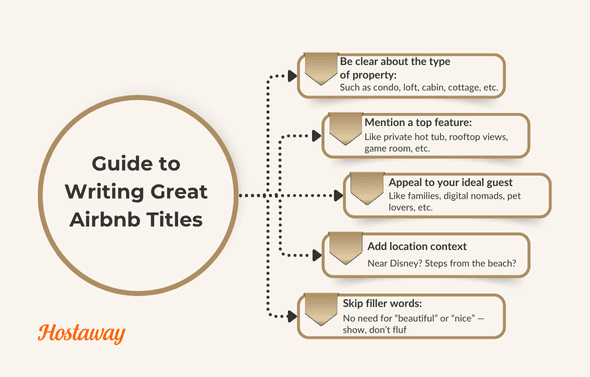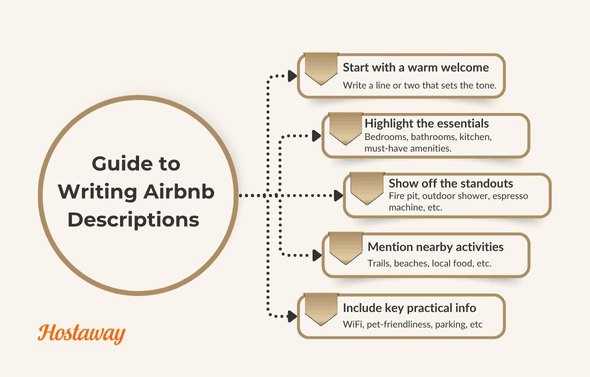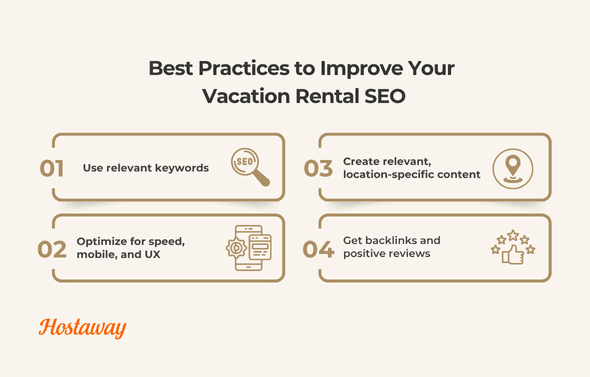Vacation Rental Marketing Ultimate Guide

The vacation rental industry is having a moment and it's not just a passing trend.
According to Statista, vacation rentals are expected to generate over US$105 billion in global revenue in 2025, with that figure jumping to US$125.58 billion by 2029. Even more staggering? Over 1 billion users are projected to be booking vacation stays by the end of this decade.
In short, business is booming. But booming markets bring something else with them — competition.
Why Marketing Your Vacation Rental Really Matters
You could have the most charming cabin in the woods or a perfectly polished beachfront condo. But if no one sees it? It’s just another hidden gem lost in a sea of listings.
With millions of properties listed on platforms like Airbnb, Vrbo and Booking.com, standing out takes more than nice photos and good vibes. To attract the right guests, boost bookings and turn lookers into loyal fans, you need a vacation rental marketing strategy that actually works.
Great marketing helps you:
Get more bookings from your ideal guests
Build trust with previous guests and prospective ones
Grow your brand beyond just OTA listings
Drive bookings through your own website
Scale your short term rental business for long-term success
Done right, vacation rental marketing isn’t just an add-on — it’s the engine that drives your growth.

You Don’t Need to Do It All — Just Do It Right
Forget trying to be everywhere all at once. The smartest vacation rental property managers don’t hustle harder — they market smarter.
Whether you’re brand new to the game or ready to scale your vacation rental business, this ultimate guide is packed with real strategies, practical tools and easy wins to help you market your vacation rental with confidence.
We’ll cover everything from building your vacation rental brand and optimizing your listings to social media marketing, SEO, email campaigns and more — all without the overwhelm.
Let’s get started.

Define Your Ideal Guest
Before you post a single listing, boost a Facebook ad or write a caption about sunset views — you need to know who you’re marketing to.
Because here’s the truth, you can’t market what you don’t understand. And in the short-term rental business, your target audience is everything.
Are you aiming for digital nomads who crave fast WiFi and coffee shops nearby? Or families who need bunk beds, blackout curtains and space to roam? Maybe it’s business travelers, pet parents or couples seeking weekend escapes.
Your vacation rental marketing strategy should be built around what your prospective guest wants — and how your property delivers it.
What knowing your target guest unlocks:
Where to market (Instagram reels? Google Ads? Travel forums?)
What to say (Pet-friendly peace-of-mind? Remote work dream home?)
What to offer (Cribs, streaming services, fenced yards — you name it)
A focused approach attracts more bookings from the right guests, leading to better reviews, repeat booking and less hassle for you.
Common guest profiles (and what they look for):
Guest Type | What they prioritize |
|---|---|
Families | Safety, kitchens, laundry, and plenty of space |
Digital Nomads | High-speed WiFi, desk space, walkable neighborhoods |
Couples | Privacy, ambiance, and Instagram-worthy aesthetics |
Pet Owners | Outdoor areas, pet policies, and pet-friendly listings |
Event Guests | Proximity to venues, flexible check-in, group capacity |
Not sure who your target audience is? Start here:
Review past bookings: Who's stayed before? That’s your starting point.
Check similar listings: See who your competitors are attracting.
Audit your amenities: Sometimes your features tell you exactly who you’re meant to host.
Use Hostaway’s analytics: The Hostaway analytics and reporting tools give clear insights into who’s booking, when and why.
Craft the Perfect Listing
You could have the most stunning vacation rental property on the block — designer furniture, dreamy lighting, a view that makes people gasp — but if your listing doesn’t do it justice, most guests will scroll right past your property page.
Whether you're posting on Airbnb, Vrbo or your own website, your listing is your first impression. It’s your storefront, sales pitch and invitation — all in one. And it needs to do one thing really well, convert potential guests into booked guests.
A great short-term rental listing:
Highlights what makes your property unique
Shows (not just tells) potential guests why they should stay
Sets expectations clearly to avoid surprises or negative reviews
In this section, we’ll cover the key ingredients that make a listing irresistible — from stunning visuals to scroll-stopping titles and descriptions that actually get read.

Start with stunning photos
When guests scroll through short-term rentals, they’re not reading — they’re scanning. And what grabs their attention first (and hardest)? Your photos.
Your listing’s images are your first impression, your sales pitch and your visual promise — all rolled into one. If the lighting’s off, the angles are awkward or the photo quality screams “grainy iPhone 6,” you’re sending guests straight to your competitors.
Why high-quality, professional photos matter (A lot)
According to a study by Futurestay, listings with 20 or more high-quality images are 20% more likely to get booked. That’s not just a nice bump — that’s potentially thousands of dollars in extra income for your vacation rental business each year.
Great visuals:
Build trust instantly with potential guests
Make your vacation rental property look its best
Increase time spent on your listing (which boosts visibility on platforms)
And while some listing sites limit your photo count, your direct booking website gives you full control.
Pro tips for getting it right:
Tip | Description |
|---|---|
Use natural light | Morning or early evening light works best |
Shoot wide angles from corners | This helps show off space and flow |
Stage the space | Think clean counters, cozy touches, and a lived-in feel |
Highlight key features | Pool? Fireplace? Patio with a view? Showcase them |
Hire a professional photographer | It’s a one-time investment that can seriously boost bookings |
Even if you're just starting your vacation rental marketing strategy, quality photos are one of the easiest ways to stand out — and it’s one of the few upgrades that pays for itself.
Craft a click-worthy title
Think of your listing title as the headline of your vacation rental property’s dating profile — it’s got one job: stop the scroll and spark curiosity.
In a sea of “Cozy 2-Bedroom Apartment” titles, yours needs to do more than describe — it needs to entice. Whether it’s on listing sites like Airbnb, Vrbo or on your own vacation rental website, a strong title can be the difference between a passive glance and a confirmed booking.

What makes a great title?
A great title is clear, specific and full of personality. It highlights what makes your place stand out — not just what it is, but what it offers.
Here’s what to aim for:
Be clear about the type of property: condo, loft, cabin, cottage
Mention a top feature: private hot tub, rooftop views, game room, etc.
Appeal to your ideal guest: families, digital nomads, pet lovers
Add location context: Near Disney? Steps from the beach? Let them know
Skip filler words: No need for “beautiful” or “nice” — show, don’t fluff
Write descriptions that make guests feel something
Once your title grabs attention and your photos do their job, your listing description is where you seal the deal. It’s your chance to tell a story — not just about the property, but about the experience of staying there.
This isn’t just about listing square footage and bed counts. It’s about painting a picture. You want potential guests to imagine waking up to ocean views, sipping coffee on the balcony or curling up by the fireplace after a day of skiing. Give them a reason to say, “This is exactly what we’ve been looking for.”

What to include in your description
Think of your description like a guided tour. You’re walking your guest from room to room, pointing out what makes your space special and showing them what it feels like to live there — even if just for a weekend. You're not just describing a short-term rental property — you're inviting them to experience it.
A few writing tips:
Use descriptive, sensory language: Help them hear, see and feel the space
Keep the tone inviting and personal — imagine writing to a friend
Break up large blocks of text with short paragraphs or bullet points
Avoid generic terms (“nice kitchen”) and go for specifics (“chef’s kitchen with a five-burner gas stove”
Protip: Don’t start with “This is a 2-bedroom unit.” Start with “Tucked away in the hills, this sunlit escape is perfect for slow mornings and late-night laughs under the stars.”. Lead with the experience, then fill in the details.
Don’t skip the details
Many vacation rental owners focus on flair and forget the fundamentals. Be sure to include:
Max occupancy
Bed configurations
Any restrictions or rules
Check-in/out times
Unique amenities (hello, hammock!)
Most vacation rental platforms have separate fields for rates and house rules, but your description still does the heavy lifting when it comes to building trust and excitement.

Build Trust Through Guest Reviews
In the world of vacation rental marketing, guest reviews are one of your most powerful tools. They build trust with new guests, improve your visibility on OTAs and serve as social proof that your property delivers on its promises.
Encouraging reviews doesn’t have to be complicated — a friendly follow-up message after checkout or an automated request through your vacation rental software can go a long way. And don’t forget to respond to every review — even the not-so-great ones. Your replies show future guests that you care about their experience and are committed to providing a great stay.
To make your reviews work even harder, consider using a tool like Revyoos. It pulls your guest reviews from OTA listings and displays them all in one place on your short-term rental website. This boosts your credibility, strengthens your brand and help increase bookings — all without lifting a finger.
Determine the Right Mix of Booking Channels
To get your property in front of more potential guests, you need to meet them where they already are. That means showing up on multiple OTAs (Online Travel Agencies) like Airbnb and Vrbo. Each one brings a different audience — families, solo travelers, international guests — and tapping into that variety gives your vacation rental property the best chance of staying booked year-round.
Not all OTAs are created equal
Different platforms perform better with different kinds of guests:
OTA | Types of guests its popular with |
|---|---|
Airbnb | Flexible for a wide range of travelers and locations |
Vrbo | A favorite for families and longer stays |
Booking.com | Popular with international guests and urban travelers |
Tripadvisor | Strong with travel-savvy planners and reviews-driven bookers |
By listing across multiple sites, you extend your reach and reduce reliance on any one platform.
Protip: Avoid calendar chaos and double bookings by using a channel manager like Hostaway. It automatically syncs your listings across all major OTAs and your website so your availability is always up-to-date.
Boost Visibility with SEO
Search engines are where vacation dreams begin. Before guests even open Airbnb or Vrbo, many type something into Google like: “Pet-friendly cabins near Asheville” “Best places to stay in Palm Springs”
If you want to drive organic traffic, you need to show up in those results — and that’s where Search Engine Optimization (SEO) comes in. It’s one of the most cost-effective and powerful digital marketing strategies for vacation rental owners who want to bring in more traffic, more guests and ultimately — more bookings.
Just know, SEO takes time. Unlike ads, results aren’t instant — but the traffic you earn sticks around much longer. It’s a marathon, not a sprint.

Best practices to improve your vacation rental SEO
Here’s how to get started without needing to become a search engine optimization wizard overnight:
1. Use relevant keywords
Include phrases your ideal guests are searching for — like “family-friendly vacation rentals in Charleston” — in your website, blog and listing content.
2. Create location-specific content
Write blog posts like “Top 5 Free Things to Do in [Your City]” and relevant content to rank for travel-related searches in your area.
3. Optimize for speed, mobile and UX
Google prioritizes fast, mobile-friendly, secure sites. Make sure your site:
Loads quickly (under 3 seconds)
Works on all devices
Uses HTTPS (SSL)
Has clear CTAs like “Book Now”
4. Get backlinks and reviews
Encourage reviews on Google, get listed in local blogs and partner with other local businesses — Google sees this as proof of credibility.
Protip: Use Hostaway to build a direct booking site with SEO best practices built in — including blog support, Google integration and mobile-ready templates.
Take Advantage of Google Business Profile
Want an easy, free way to make your vacation rental more visible in local search results? Google Business Profile is your not-so-secret weapon.
By creating a free business profile, your property can show up in Google Maps, local search results and even those handy info boxes when someone searches for you directly. It helps previous guests find you again and builds trust with potential guests who are checking out your vacation rental business online.
And with 175+ new websites launched every minute, anything you can do to stand out in the crowd is a win.
%20Ads.png?u=https%3A%2F%2Fimages.ctfassets.net%2Fpqmtoyw9z10u%2F4P4vc0Ob0yS5ft1qHfN1QV%2F851007a572f2d3839b7eb0def6ad36f0%2FMake_Your_Marketing_Work_Faster_with_Pay_Per_Click__PPC__Ads.png&a=w%3D590%26h%3D377%26fm%3Dpng%26q%3D75&cd=2025-06-16T10%3A51%3A22.445Z)
Drive Faster Results with PPC Ads
Spending money on ads can feel a little intimidating — especially when there are free marketing tactics out there. But when it’s done right, pay-per-click (PPC) advertising, like Google Ads, can give your vacation rental an edge that free methods just can’t match.
PPC lets you target people actively searching for places to stay — and here's the kicker: your ad can appear above major OTAs like Airbnb and Vrbo in Google’s search results. That means you’re not just competing — you’re outpacing.
Pro tip: Choose a focused campaign — maybe targeting specific events in your area — and run it with a modest budget. Experiment with different keywords, headlines and images to see what gets clicks
Leverage Social Media to Showcase Your Vacation Rental
Social media marketing is one of the most powerful (and often free) tools in your vacation rental marketing strategy. It’s where potential guests discover new places, plan trips and get inspired — often before they even hit the OTAs.

Facebook as a social media platform, is a goldmine for vacation rental visibility — and it’s not just about ads. Join local tourism groups and short-term rental communities to answer questions, share tips and subtly highlight your property. Being a helpful presence builds trust and keeps your rental top of mind.
You can also join host groups to exchange ideas, get feedback and even cross-promote bookings with other hosts.
If you have a small marketing budget, Facebook Ads let you target travelers by location, interest and behavior — making it easier to reach the right guests at the right time.

Instagram is where your property’s personality comes to life. It’s a visual-first social media site — perfect for showing off your vacation rental’s design, views and special touches. Use a mix of high-quality photos, reels and carousel posts to highlight what makes your space unique. Think morning coffee on the balcony, sunset views from the hot tub or a cozy reading nook that looks straight out of a magazine.
Take advantage of stories and highlights to share FAQs, guest testimonials and behind-the-scenes moments like turnarounds or restocks. Don’t forget to encourage guest tagging and reshare their posts — it creates authentic content and social proof with almost no effort.

TikTok
TikTok is where authenticity meets virality — and it’s an incredible way to connect with younger travelers, especially Millennials and Gen Z. With short, punchy video content, you can show off your space’s best features in a fun, engaging way. Think: “Room Reveal,” “Hot Tub POV,” or “3 Things You’ll Love About Our Stay.”
Use trending audio clips and short captions to increase visibility in this social media site and always include a hook in the first 3 seconds to stop the scroll. Behind-the-scenes videos (like restocking snacks or prepping for guests) also perform surprisingly well — they humanize your brand and make your property more memorable.
Just remember to include a link in bio (using tools like Linktree) that directs viewers to your website or listings.
Use AI to Market Smarter
AI is quickly becoming a game-changer in vacation rental marketing, helping hosts streamline everything from listing descriptions to social media captions. With tools like Hostaway’s built-in ChatGPT Listing Description Optimizer, you can instantly enhance your property descriptions right from your dashboard. Simply click to improve the copy, regenerate until it reads just right and publish once you're happy — making it easy to highlight your property’s best features without the stress of writing from scratch.
Beyond listing descriptions, AI can also help you:
Draft SEO-friendly blog content to drive organic traffic
Create Instagram captions and TikTok video scripts
Personalize email marketing copy for different guest types
Analyze guest reviews for feedback trends
Used right, AI isn’t just a time-saver — it’s a secret weapon for building a consistent, scalable marketing strategy that works across all channels.

Ready to Market Like a Pro?
Marketing your vacation rental might feel overwhelming at first, but as you’ve seen — it doesn’t have to be. With the right strategy, the right tools and a clear understanding of your audience, you can stand out in a crowded market.
Whether you're just getting started or scaling your short-term rental business to new heights, the key is consistency, creativity and making smart use of the right platforms.
You don’t need to do everything. You just need to do the right things — really well. Start small. Stay consistent. And don’t be afraid to experiment. The bookings will follow.